Analysis of Automotive Holdings Group in Advanced Financial Accounting
VerifiedAdded on 2022/09/12
|9
|2884
|13
Report
AI Summary
This report provides an analysis of the financial accounting practices of Automotive Holdings Group, an Australian automotive company. It begins with an executive summary and table of contents, followed by an introduction highlighting the importance of financial accounting in summarizing and reporting financial transactions. The report then defines and describes a reporting entity, identifying Automotive Holdings Group as one. It explains how the company's annual report is used to determine its reporting entity status and compliance with IFRS and AASB standards. The study also explores fundamental qualitative characteristics, including relevance and representational faithfulness, and their significance in financial reporting. It discusses the importance of comparability, verifiability, timeliness, and understandability. The report concludes by emphasizing the need for accurate and unbiased financial information, including the faithful representation of assets and liabilities, as essential for informed decision-making by stakeholders. The study is based on the HA3011 Advanced Financial Accounting course at Holmes Institute.
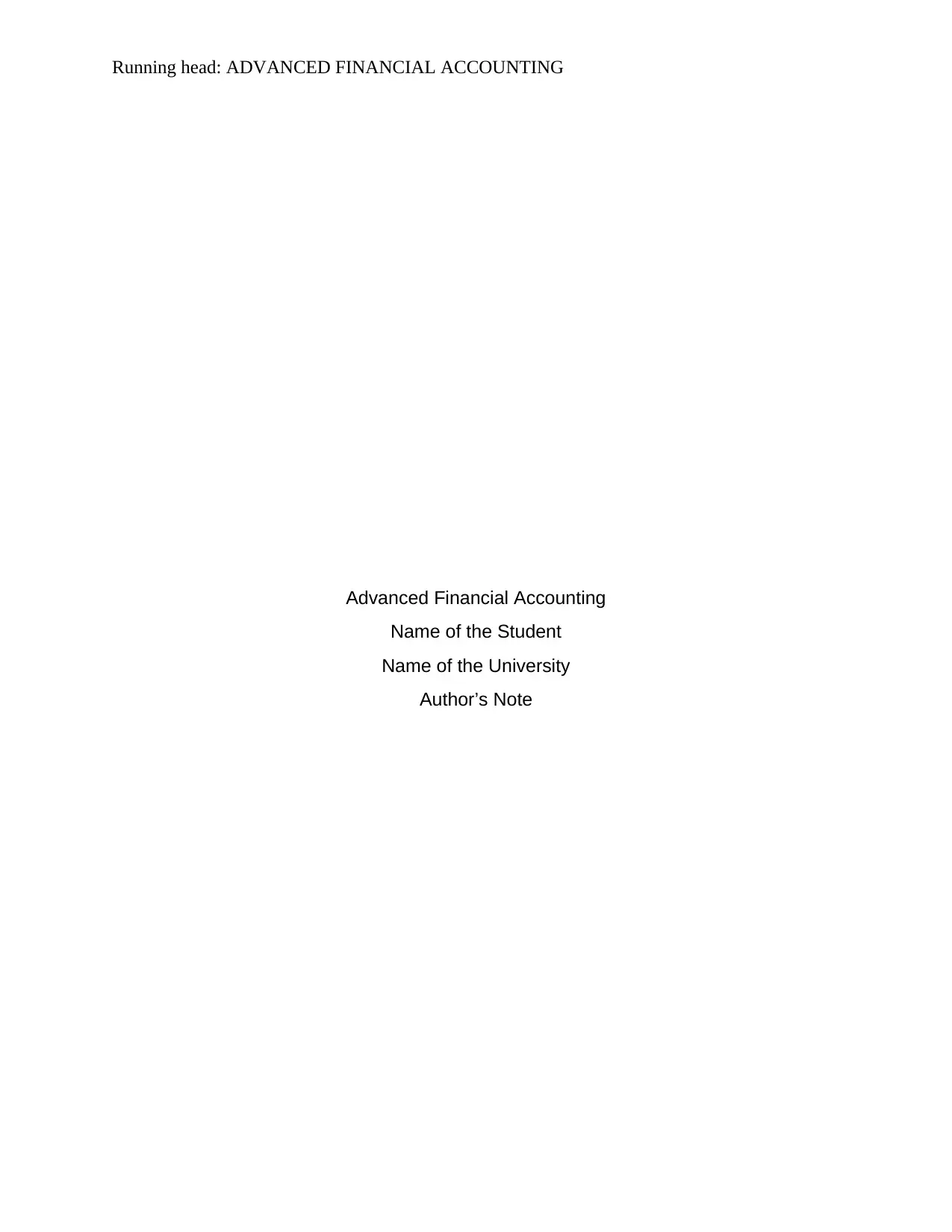
Running head: ADVANCED FINANCIAL ACCOUNTING
Advanced Financial Accounting
Name of the Student
Name of the University
Author’s Note
Advanced Financial Accounting
Name of the Student
Name of the University
Author’s Note
Paraphrase This Document
Need a fresh take? Get an instant paraphrase of this document with our AI Paraphraser
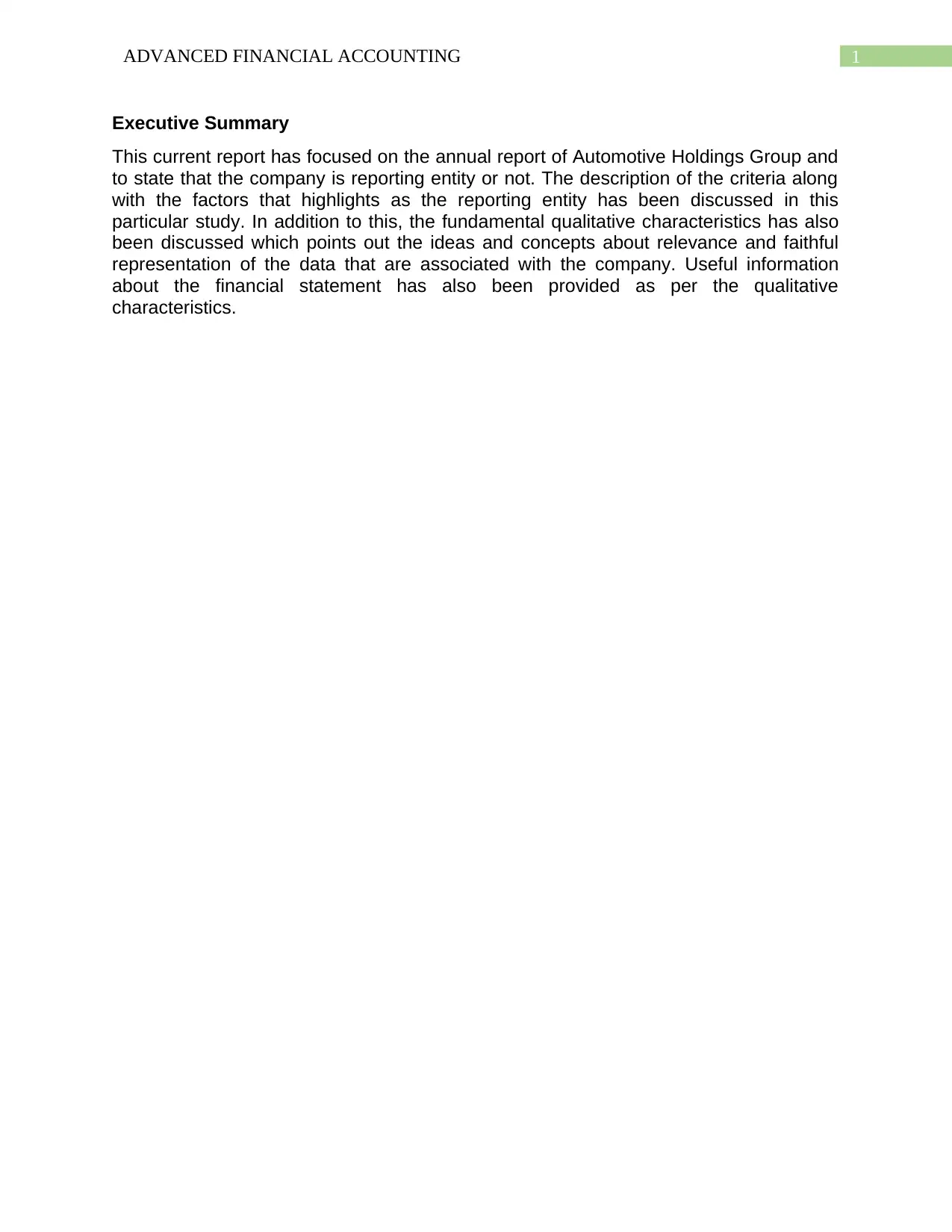
1ADVANCED FINANCIAL ACCOUNTING
Executive Summary
This current report has focused on the annual report of Automotive Holdings Group and
to state that the company is reporting entity or not. The description of the criteria along
with the factors that highlights as the reporting entity has been discussed in this
particular study. In addition to this, the fundamental qualitative characteristics has also
been discussed which points out the ideas and concepts about relevance and faithful
representation of the data that are associated with the company. Useful information
about the financial statement has also been provided as per the qualitative
characteristics.
Executive Summary
This current report has focused on the annual report of Automotive Holdings Group and
to state that the company is reporting entity or not. The description of the criteria along
with the factors that highlights as the reporting entity has been discussed in this
particular study. In addition to this, the fundamental qualitative characteristics has also
been discussed which points out the ideas and concepts about relevance and faithful
representation of the data that are associated with the company. Useful information
about the financial statement has also been provided as per the qualitative
characteristics.

2ADVANCED FINANCIAL ACCOUNTING
Table of Contents
Introduction........................................................................................................................3
Reporting Entity – Definition, Description and identification of the selected company.....3
Fundamental Qualitative Characteristics – Understanding of relevance and
representational faithfulness..............................................................................................4
Conclusion.........................................................................................................................6
References.........................................................................................................................7
Table of Contents
Introduction........................................................................................................................3
Reporting Entity – Definition, Description and identification of the selected company.....3
Fundamental Qualitative Characteristics – Understanding of relevance and
representational faithfulness..............................................................................................4
Conclusion.........................................................................................................................6
References.........................................................................................................................7
⊘ This is a preview!⊘
Do you want full access?
Subscribe today to unlock all pages.

Trusted by 1+ million students worldwide
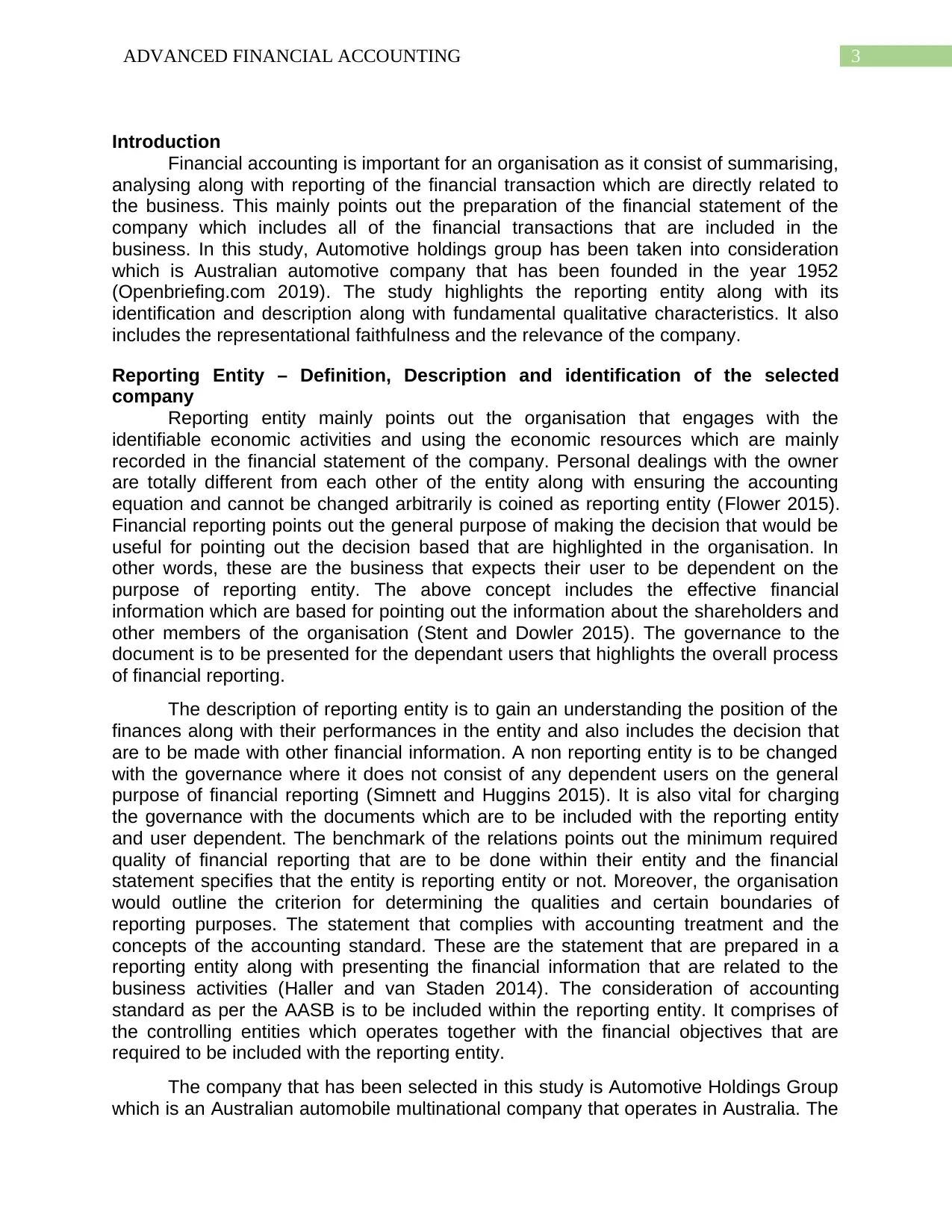
3ADVANCED FINANCIAL ACCOUNTING
Introduction
Financial accounting is important for an organisation as it consist of summarising,
analysing along with reporting of the financial transaction which are directly related to
the business. This mainly points out the preparation of the financial statement of the
company which includes all of the financial transactions that are included in the
business. In this study, Automotive holdings group has been taken into consideration
which is Australian automotive company that has been founded in the year 1952
(Openbriefing.com 2019). The study highlights the reporting entity along with its
identification and description along with fundamental qualitative characteristics. It also
includes the representational faithfulness and the relevance of the company.
Reporting Entity – Definition, Description and identification of the selected
company
Reporting entity mainly points out the organisation that engages with the
identifiable economic activities and using the economic resources which are mainly
recorded in the financial statement of the company. Personal dealings with the owner
are totally different from each other of the entity along with ensuring the accounting
equation and cannot be changed arbitrarily is coined as reporting entity (Flower 2015).
Financial reporting points out the general purpose of making the decision that would be
useful for pointing out the decision based that are highlighted in the organisation. In
other words, these are the business that expects their user to be dependent on the
purpose of reporting entity. The above concept includes the effective financial
information which are based for pointing out the information about the shareholders and
other members of the organisation (Stent and Dowler 2015). The governance to the
document is to be presented for the dependant users that highlights the overall process
of financial reporting.
The description of reporting entity is to gain an understanding the position of the
finances along with their performances in the entity and also includes the decision that
are to be made with other financial information. A non reporting entity is to be changed
with the governance where it does not consist of any dependent users on the general
purpose of financial reporting (Simnett and Huggins 2015). It is also vital for charging
the governance with the documents which are to be included with the reporting entity
and user dependent. The benchmark of the relations points out the minimum required
quality of financial reporting that are to be done within their entity and the financial
statement specifies that the entity is reporting entity or not. Moreover, the organisation
would outline the criterion for determining the qualities and certain boundaries of
reporting purposes. The statement that complies with accounting treatment and the
concepts of the accounting standard. These are the statement that are prepared in a
reporting entity along with presenting the financial information that are related to the
business activities (Haller and van Staden 2014). The consideration of accounting
standard as per the AASB is to be included within the reporting entity. It comprises of
the controlling entities which operates together with the financial objectives that are
required to be included with the reporting entity.
The company that has been selected in this study is Automotive Holdings Group
which is an Australian automobile multinational company that operates in Australia. The
Introduction
Financial accounting is important for an organisation as it consist of summarising,
analysing along with reporting of the financial transaction which are directly related to
the business. This mainly points out the preparation of the financial statement of the
company which includes all of the financial transactions that are included in the
business. In this study, Automotive holdings group has been taken into consideration
which is Australian automotive company that has been founded in the year 1952
(Openbriefing.com 2019). The study highlights the reporting entity along with its
identification and description along with fundamental qualitative characteristics. It also
includes the representational faithfulness and the relevance of the company.
Reporting Entity – Definition, Description and identification of the selected
company
Reporting entity mainly points out the organisation that engages with the
identifiable economic activities and using the economic resources which are mainly
recorded in the financial statement of the company. Personal dealings with the owner
are totally different from each other of the entity along with ensuring the accounting
equation and cannot be changed arbitrarily is coined as reporting entity (Flower 2015).
Financial reporting points out the general purpose of making the decision that would be
useful for pointing out the decision based that are highlighted in the organisation. In
other words, these are the business that expects their user to be dependent on the
purpose of reporting entity. The above concept includes the effective financial
information which are based for pointing out the information about the shareholders and
other members of the organisation (Stent and Dowler 2015). The governance to the
document is to be presented for the dependant users that highlights the overall process
of financial reporting.
The description of reporting entity is to gain an understanding the position of the
finances along with their performances in the entity and also includes the decision that
are to be made with other financial information. A non reporting entity is to be changed
with the governance where it does not consist of any dependent users on the general
purpose of financial reporting (Simnett and Huggins 2015). It is also vital for charging
the governance with the documents which are to be included with the reporting entity
and user dependent. The benchmark of the relations points out the minimum required
quality of financial reporting that are to be done within their entity and the financial
statement specifies that the entity is reporting entity or not. Moreover, the organisation
would outline the criterion for determining the qualities and certain boundaries of
reporting purposes. The statement that complies with accounting treatment and the
concepts of the accounting standard. These are the statement that are prepared in a
reporting entity along with presenting the financial information that are related to the
business activities (Haller and van Staden 2014). The consideration of accounting
standard as per the AASB is to be included within the reporting entity. It comprises of
the controlling entities which operates together with the financial objectives that are
required to be included with the reporting entity.
The company that has been selected in this study is Automotive Holdings Group
which is an Australian automobile multinational company that operates in Australia. The
Paraphrase This Document
Need a fresh take? Get an instant paraphrase of this document with our AI Paraphraser
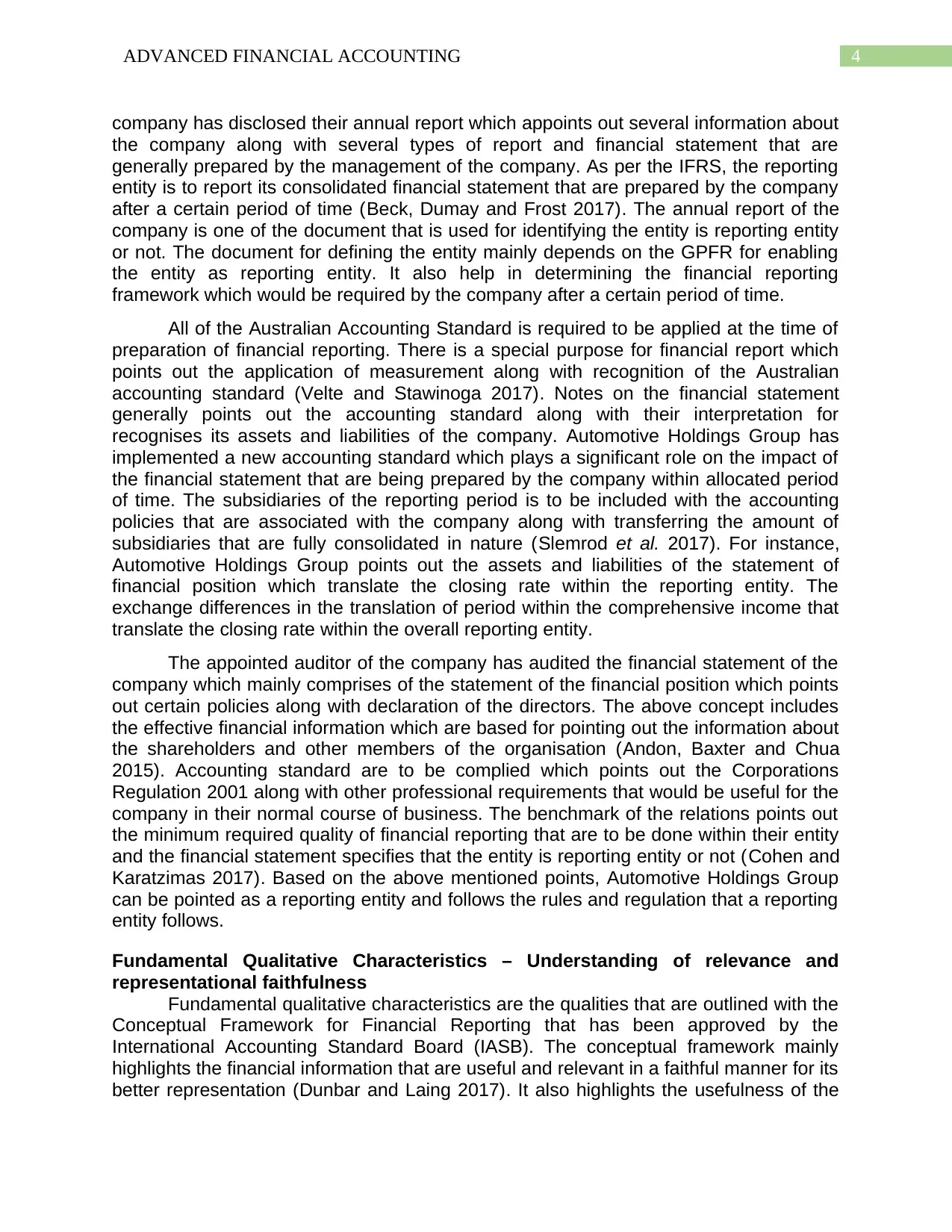
4ADVANCED FINANCIAL ACCOUNTING
company has disclosed their annual report which appoints out several information about
the company along with several types of report and financial statement that are
generally prepared by the management of the company. As per the IFRS, the reporting
entity is to report its consolidated financial statement that are prepared by the company
after a certain period of time (Beck, Dumay and Frost 2017). The annual report of the
company is one of the document that is used for identifying the entity is reporting entity
or not. The document for defining the entity mainly depends on the GPFR for enabling
the entity as reporting entity. It also help in determining the financial reporting
framework which would be required by the company after a certain period of time.
All of the Australian Accounting Standard is required to be applied at the time of
preparation of financial reporting. There is a special purpose for financial report which
points out the application of measurement along with recognition of the Australian
accounting standard (Velte and Stawinoga 2017). Notes on the financial statement
generally points out the accounting standard along with their interpretation for
recognises its assets and liabilities of the company. Automotive Holdings Group has
implemented a new accounting standard which plays a significant role on the impact of
the financial statement that are being prepared by the company within allocated period
of time. The subsidiaries of the reporting period is to be included with the accounting
policies that are associated with the company along with transferring the amount of
subsidiaries that are fully consolidated in nature (Slemrod et al. 2017). For instance,
Automotive Holdings Group points out the assets and liabilities of the statement of
financial position which translate the closing rate within the reporting entity. The
exchange differences in the translation of period within the comprehensive income that
translate the closing rate within the overall reporting entity.
The appointed auditor of the company has audited the financial statement of the
company which mainly comprises of the statement of the financial position which points
out certain policies along with declaration of the directors. The above concept includes
the effective financial information which are based for pointing out the information about
the shareholders and other members of the organisation (Andon, Baxter and Chua
2015). Accounting standard are to be complied which points out the Corporations
Regulation 2001 along with other professional requirements that would be useful for the
company in their normal course of business. The benchmark of the relations points out
the minimum required quality of financial reporting that are to be done within their entity
and the financial statement specifies that the entity is reporting entity or not (Cohen and
Karatzimas 2017). Based on the above mentioned points, Automotive Holdings Group
can be pointed as a reporting entity and follows the rules and regulation that a reporting
entity follows.
Fundamental Qualitative Characteristics – Understanding of relevance and
representational faithfulness
Fundamental qualitative characteristics are the qualities that are outlined with the
Conceptual Framework for Financial Reporting that has been approved by the
International Accounting Standard Board (IASB). The conceptual framework mainly
highlights the financial information that are useful and relevant in a faithful manner for its
better representation (Dunbar and Laing 2017). It also highlights the usefulness of the
company has disclosed their annual report which appoints out several information about
the company along with several types of report and financial statement that are
generally prepared by the management of the company. As per the IFRS, the reporting
entity is to report its consolidated financial statement that are prepared by the company
after a certain period of time (Beck, Dumay and Frost 2017). The annual report of the
company is one of the document that is used for identifying the entity is reporting entity
or not. The document for defining the entity mainly depends on the GPFR for enabling
the entity as reporting entity. It also help in determining the financial reporting
framework which would be required by the company after a certain period of time.
All of the Australian Accounting Standard is required to be applied at the time of
preparation of financial reporting. There is a special purpose for financial report which
points out the application of measurement along with recognition of the Australian
accounting standard (Velte and Stawinoga 2017). Notes on the financial statement
generally points out the accounting standard along with their interpretation for
recognises its assets and liabilities of the company. Automotive Holdings Group has
implemented a new accounting standard which plays a significant role on the impact of
the financial statement that are being prepared by the company within allocated period
of time. The subsidiaries of the reporting period is to be included with the accounting
policies that are associated with the company along with transferring the amount of
subsidiaries that are fully consolidated in nature (Slemrod et al. 2017). For instance,
Automotive Holdings Group points out the assets and liabilities of the statement of
financial position which translate the closing rate within the reporting entity. The
exchange differences in the translation of period within the comprehensive income that
translate the closing rate within the overall reporting entity.
The appointed auditor of the company has audited the financial statement of the
company which mainly comprises of the statement of the financial position which points
out certain policies along with declaration of the directors. The above concept includes
the effective financial information which are based for pointing out the information about
the shareholders and other members of the organisation (Andon, Baxter and Chua
2015). Accounting standard are to be complied which points out the Corporations
Regulation 2001 along with other professional requirements that would be useful for the
company in their normal course of business. The benchmark of the relations points out
the minimum required quality of financial reporting that are to be done within their entity
and the financial statement specifies that the entity is reporting entity or not (Cohen and
Karatzimas 2017). Based on the above mentioned points, Automotive Holdings Group
can be pointed as a reporting entity and follows the rules and regulation that a reporting
entity follows.
Fundamental Qualitative Characteristics – Understanding of relevance and
representational faithfulness
Fundamental qualitative characteristics are the qualities that are outlined with the
Conceptual Framework for Financial Reporting that has been approved by the
International Accounting Standard Board (IASB). The conceptual framework mainly
highlights the financial information that are useful and relevant in a faithful manner for its
better representation (Dunbar and Laing 2017). It also highlights the usefulness of the

5ADVANCED FINANCIAL ACCOUNTING
financial information which enhances the comparability, timely and understandable
within the allocated time period. The financial statement of the company provides the
relevant information which is also capable of making the differences in certain type of
decision that are made by the user. Any kind of relevance queries about the relevant
financial information are directly related to the economic decision along with its values
that are predictive in nature. The predictive value of the information highlights the
confirmatory value which generally anticipates the future outcome. It also consist of
another aspects that is materiality which is entity specific in nature (Toma, Carp and
Robu 2015). The relative in nature of materiality is affected by its magnitude which
highlights the relative information within the financial statement that has been prepared
by the company.
Qualitative characteristics is also to be enhanced for better results within the
entity for its reporting purpose. Some of the quality that are to be enhanced includes the
comparability, verifiability, timeliness and understandability (Zhong and Li 2017).
Comparability mainly points out the comparison within the organisation and across the
organisation that has to be compared from one accounting period to another
accounting. For instance, Automotive Holdings Group is to compare their financial
statement from one year to another year. Income is to be compared for the year that
highlights the year such as 2016, 2017 along with 2018. It mainly highlights the
similarities and the differences between the statements that are being prepared by the
company (Nobes and Stadler 2015). Verifiability generally assists the user that the
included information has been faithfully represented and supported by the evidences for
checking the overall faithfulness of the financial statements. Timeliness mainly points
out the information that are required to be provided to the decision makers and in order
to capable of their decision within the estimated period of time. Understandability points
out the financial information which are to be included with the comprehensive financial
statement of the company and reasonable knowledge of the business is to be included
with certain economic activities. For understanding the business activities, the
information about the company is to be presented in a clear way along with in a concise
manner as it would help in presenting the information in a better way. It might not be
improper to exclude the business along with the complex items for understanding the
financial reports in simple terms.
Moreover, the faithful representation represents the actual purpose of the report
which actually means that to represent what has actually happened in the business of
the company. There are certain characteristics through which faithful representation of
the data is performed which are completeness, neutrality and free from errors (Palea
2014). Completeness mainly refers to the adequate or full disclosure of the necessary
information which are to be included in the financial statement of the company. Any
information should not be kept as secret and every information is to be disclosed during
the time of reporting. Neutrality mainly refers to the fairness and freedom of the
information which are totally free from bias. Any kind of misinterpretation is not to be
included at the time of recording of financial statements. In addition to this, free from
errors are the quality which are to be included that consist of no inaccuracies and
omission of financial information during the time of recording. Analysis of financial
financial information which enhances the comparability, timely and understandable
within the allocated time period. The financial statement of the company provides the
relevant information which is also capable of making the differences in certain type of
decision that are made by the user. Any kind of relevance queries about the relevant
financial information are directly related to the economic decision along with its values
that are predictive in nature. The predictive value of the information highlights the
confirmatory value which generally anticipates the future outcome. It also consist of
another aspects that is materiality which is entity specific in nature (Toma, Carp and
Robu 2015). The relative in nature of materiality is affected by its magnitude which
highlights the relative information within the financial statement that has been prepared
by the company.
Qualitative characteristics is also to be enhanced for better results within the
entity for its reporting purpose. Some of the quality that are to be enhanced includes the
comparability, verifiability, timeliness and understandability (Zhong and Li 2017).
Comparability mainly points out the comparison within the organisation and across the
organisation that has to be compared from one accounting period to another
accounting. For instance, Automotive Holdings Group is to compare their financial
statement from one year to another year. Income is to be compared for the year that
highlights the year such as 2016, 2017 along with 2018. It mainly highlights the
similarities and the differences between the statements that are being prepared by the
company (Nobes and Stadler 2015). Verifiability generally assists the user that the
included information has been faithfully represented and supported by the evidences for
checking the overall faithfulness of the financial statements. Timeliness mainly points
out the information that are required to be provided to the decision makers and in order
to capable of their decision within the estimated period of time. Understandability points
out the financial information which are to be included with the comprehensive financial
statement of the company and reasonable knowledge of the business is to be included
with certain economic activities. For understanding the business activities, the
information about the company is to be presented in a clear way along with in a concise
manner as it would help in presenting the information in a better way. It might not be
improper to exclude the business along with the complex items for understanding the
financial reports in simple terms.
Moreover, the faithful representation represents the actual purpose of the report
which actually means that to represent what has actually happened in the business of
the company. There are certain characteristics through which faithful representation of
the data is performed which are completeness, neutrality and free from errors (Palea
2014). Completeness mainly refers to the adequate or full disclosure of the necessary
information which are to be included in the financial statement of the company. Any
information should not be kept as secret and every information is to be disclosed during
the time of reporting. Neutrality mainly refers to the fairness and freedom of the
information which are totally free from bias. Any kind of misinterpretation is not to be
included at the time of recording of financial statements. In addition to this, free from
errors are the quality which are to be included that consist of no inaccuracies and
omission of financial information during the time of recording. Analysis of financial
⊘ This is a preview!⊘
Do you want full access?
Subscribe today to unlock all pages.

Trusted by 1+ million students worldwide
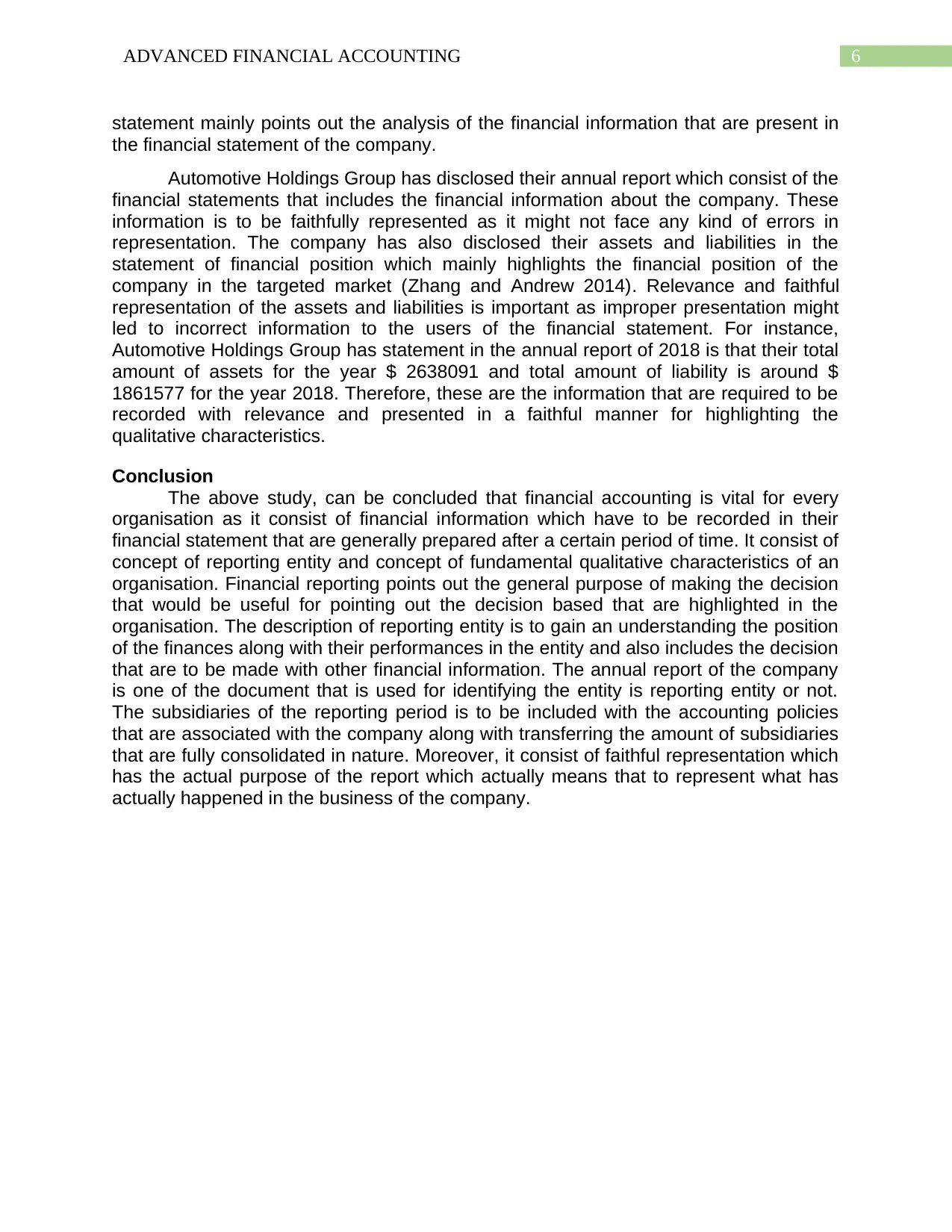
6ADVANCED FINANCIAL ACCOUNTING
statement mainly points out the analysis of the financial information that are present in
the financial statement of the company.
Automotive Holdings Group has disclosed their annual report which consist of the
financial statements that includes the financial information about the company. These
information is to be faithfully represented as it might not face any kind of errors in
representation. The company has also disclosed their assets and liabilities in the
statement of financial position which mainly highlights the financial position of the
company in the targeted market (Zhang and Andrew 2014). Relevance and faithful
representation of the assets and liabilities is important as improper presentation might
led to incorrect information to the users of the financial statement. For instance,
Automotive Holdings Group has statement in the annual report of 2018 is that their total
amount of assets for the year $ 2638091 and total amount of liability is around $
1861577 for the year 2018. Therefore, these are the information that are required to be
recorded with relevance and presented in a faithful manner for highlighting the
qualitative characteristics.
Conclusion
The above study, can be concluded that financial accounting is vital for every
organisation as it consist of financial information which have to be recorded in their
financial statement that are generally prepared after a certain period of time. It consist of
concept of reporting entity and concept of fundamental qualitative characteristics of an
organisation. Financial reporting points out the general purpose of making the decision
that would be useful for pointing out the decision based that are highlighted in the
organisation. The description of reporting entity is to gain an understanding the position
of the finances along with their performances in the entity and also includes the decision
that are to be made with other financial information. The annual report of the company
is one of the document that is used for identifying the entity is reporting entity or not.
The subsidiaries of the reporting period is to be included with the accounting policies
that are associated with the company along with transferring the amount of subsidiaries
that are fully consolidated in nature. Moreover, it consist of faithful representation which
has the actual purpose of the report which actually means that to represent what has
actually happened in the business of the company.
statement mainly points out the analysis of the financial information that are present in
the financial statement of the company.
Automotive Holdings Group has disclosed their annual report which consist of the
financial statements that includes the financial information about the company. These
information is to be faithfully represented as it might not face any kind of errors in
representation. The company has also disclosed their assets and liabilities in the
statement of financial position which mainly highlights the financial position of the
company in the targeted market (Zhang and Andrew 2014). Relevance and faithful
representation of the assets and liabilities is important as improper presentation might
led to incorrect information to the users of the financial statement. For instance,
Automotive Holdings Group has statement in the annual report of 2018 is that their total
amount of assets for the year $ 2638091 and total amount of liability is around $
1861577 for the year 2018. Therefore, these are the information that are required to be
recorded with relevance and presented in a faithful manner for highlighting the
qualitative characteristics.
Conclusion
The above study, can be concluded that financial accounting is vital for every
organisation as it consist of financial information which have to be recorded in their
financial statement that are generally prepared after a certain period of time. It consist of
concept of reporting entity and concept of fundamental qualitative characteristics of an
organisation. Financial reporting points out the general purpose of making the decision
that would be useful for pointing out the decision based that are highlighted in the
organisation. The description of reporting entity is to gain an understanding the position
of the finances along with their performances in the entity and also includes the decision
that are to be made with other financial information. The annual report of the company
is one of the document that is used for identifying the entity is reporting entity or not.
The subsidiaries of the reporting period is to be included with the accounting policies
that are associated with the company along with transferring the amount of subsidiaries
that are fully consolidated in nature. Moreover, it consist of faithful representation which
has the actual purpose of the report which actually means that to represent what has
actually happened in the business of the company.
Paraphrase This Document
Need a fresh take? Get an instant paraphrase of this document with our AI Paraphraser
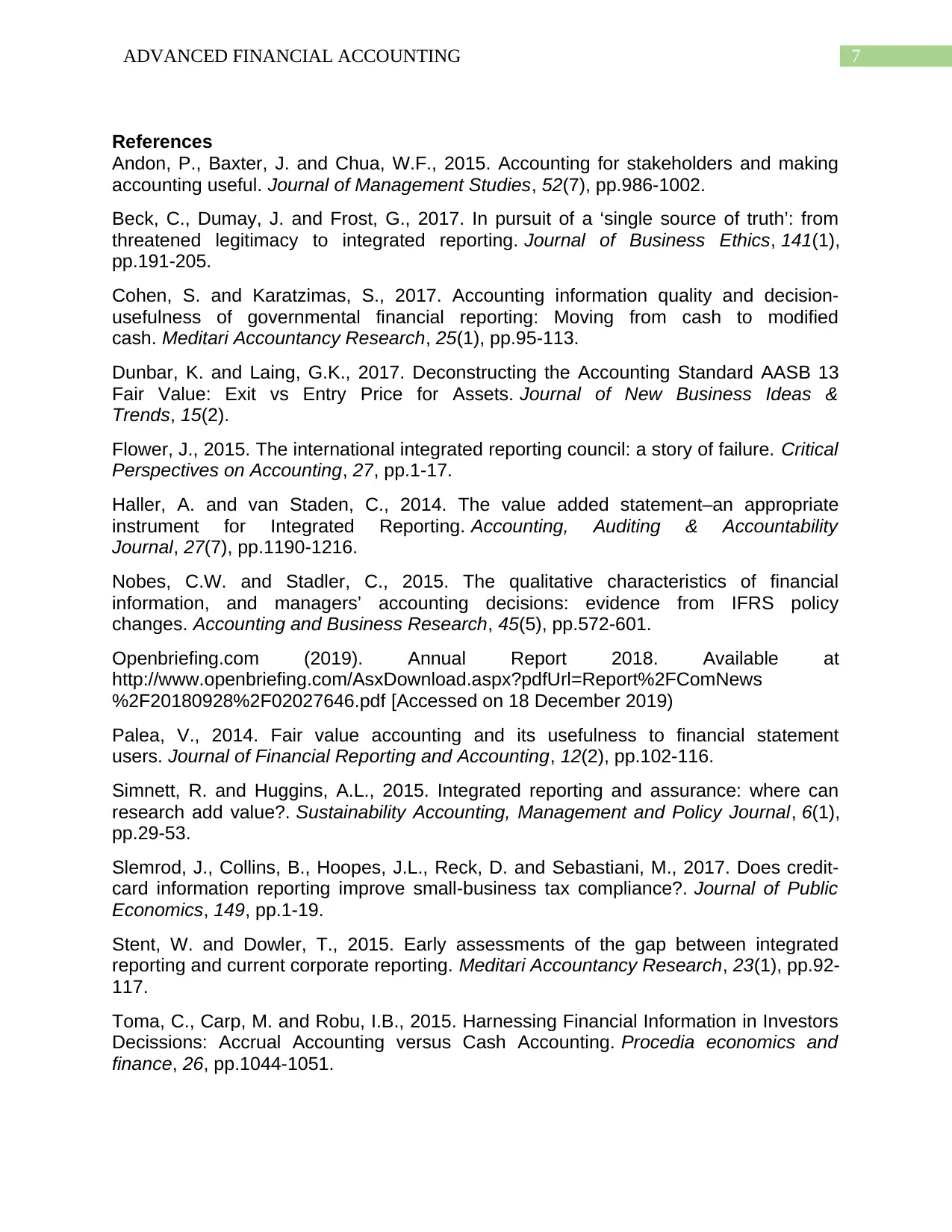
7ADVANCED FINANCIAL ACCOUNTING
References
Andon, P., Baxter, J. and Chua, W.F., 2015. Accounting for stakeholders and making
accounting useful. Journal of Management Studies, 52(7), pp.986-1002.
Beck, C., Dumay, J. and Frost, G., 2017. In pursuit of a ‘single source of truth’: from
threatened legitimacy to integrated reporting. Journal of Business Ethics, 141(1),
pp.191-205.
Cohen, S. and Karatzimas, S., 2017. Accounting information quality and decision-
usefulness of governmental financial reporting: Moving from cash to modified
cash. Meditari Accountancy Research, 25(1), pp.95-113.
Dunbar, K. and Laing, G.K., 2017. Deconstructing the Accounting Standard AASB 13
Fair Value: Exit vs Entry Price for Assets. Journal of New Business Ideas &
Trends, 15(2).
Flower, J., 2015. The international integrated reporting council: a story of failure. Critical
Perspectives on Accounting, 27, pp.1-17.
Haller, A. and van Staden, C., 2014. The value added statement–an appropriate
instrument for Integrated Reporting. Accounting, Auditing & Accountability
Journal, 27(7), pp.1190-1216.
Nobes, C.W. and Stadler, C., 2015. The qualitative characteristics of financial
information, and managers’ accounting decisions: evidence from IFRS policy
changes. Accounting and Business Research, 45(5), pp.572-601.
Openbriefing.com (2019). Annual Report 2018. Available at
http://www.openbriefing.com/AsxDownload.aspx?pdfUrl=Report%2FComNews
%2F20180928%2F02027646.pdf [Accessed on 18 December 2019)
Palea, V., 2014. Fair value accounting and its usefulness to financial statement
users. Journal of Financial Reporting and Accounting, 12(2), pp.102-116.
Simnett, R. and Huggins, A.L., 2015. Integrated reporting and assurance: where can
research add value?. Sustainability Accounting, Management and Policy Journal, 6(1),
pp.29-53.
Slemrod, J., Collins, B., Hoopes, J.L., Reck, D. and Sebastiani, M., 2017. Does credit-
card information reporting improve small-business tax compliance?. Journal of Public
Economics, 149, pp.1-19.
Stent, W. and Dowler, T., 2015. Early assessments of the gap between integrated
reporting and current corporate reporting. Meditari Accountancy Research, 23(1), pp.92-
117.
Toma, C., Carp, M. and Robu, I.B., 2015. Harnessing Financial Information in Investors
Decissions: Accrual Accounting versus Cash Accounting. Procedia economics and
finance, 26, pp.1044-1051.
References
Andon, P., Baxter, J. and Chua, W.F., 2015. Accounting for stakeholders and making
accounting useful. Journal of Management Studies, 52(7), pp.986-1002.
Beck, C., Dumay, J. and Frost, G., 2017. In pursuit of a ‘single source of truth’: from
threatened legitimacy to integrated reporting. Journal of Business Ethics, 141(1),
pp.191-205.
Cohen, S. and Karatzimas, S., 2017. Accounting information quality and decision-
usefulness of governmental financial reporting: Moving from cash to modified
cash. Meditari Accountancy Research, 25(1), pp.95-113.
Dunbar, K. and Laing, G.K., 2017. Deconstructing the Accounting Standard AASB 13
Fair Value: Exit vs Entry Price for Assets. Journal of New Business Ideas &
Trends, 15(2).
Flower, J., 2015. The international integrated reporting council: a story of failure. Critical
Perspectives on Accounting, 27, pp.1-17.
Haller, A. and van Staden, C., 2014. The value added statement–an appropriate
instrument for Integrated Reporting. Accounting, Auditing & Accountability
Journal, 27(7), pp.1190-1216.
Nobes, C.W. and Stadler, C., 2015. The qualitative characteristics of financial
information, and managers’ accounting decisions: evidence from IFRS policy
changes. Accounting and Business Research, 45(5), pp.572-601.
Openbriefing.com (2019). Annual Report 2018. Available at
http://www.openbriefing.com/AsxDownload.aspx?pdfUrl=Report%2FComNews
%2F20180928%2F02027646.pdf [Accessed on 18 December 2019)
Palea, V., 2014. Fair value accounting and its usefulness to financial statement
users. Journal of Financial Reporting and Accounting, 12(2), pp.102-116.
Simnett, R. and Huggins, A.L., 2015. Integrated reporting and assurance: where can
research add value?. Sustainability Accounting, Management and Policy Journal, 6(1),
pp.29-53.
Slemrod, J., Collins, B., Hoopes, J.L., Reck, D. and Sebastiani, M., 2017. Does credit-
card information reporting improve small-business tax compliance?. Journal of Public
Economics, 149, pp.1-19.
Stent, W. and Dowler, T., 2015. Early assessments of the gap between integrated
reporting and current corporate reporting. Meditari Accountancy Research, 23(1), pp.92-
117.
Toma, C., Carp, M. and Robu, I.B., 2015. Harnessing Financial Information in Investors
Decissions: Accrual Accounting versus Cash Accounting. Procedia economics and
finance, 26, pp.1044-1051.

8ADVANCED FINANCIAL ACCOUNTING
Velte, P. and Stawinoga, M., 2017. Integrated reporting: The current state of empirical
research, limitations and future research implications. Journal of Management
Control, 28(3), pp.275-320.
Zhang, Y. and Andrew, J., 2014. Financialisation and the conceptual framework. Critical
perspectives on accounting, 25(1), pp.17-26.
Zhong, Y. and Li, W., 2017. Accounting conservatism: A literature review. Australian
Accounting Review, 27(2), pp.195-213.
Velte, P. and Stawinoga, M., 2017. Integrated reporting: The current state of empirical
research, limitations and future research implications. Journal of Management
Control, 28(3), pp.275-320.
Zhang, Y. and Andrew, J., 2014. Financialisation and the conceptual framework. Critical
perspectives on accounting, 25(1), pp.17-26.
Zhong, Y. and Li, W., 2017. Accounting conservatism: A literature review. Australian
Accounting Review, 27(2), pp.195-213.
⊘ This is a preview!⊘
Do you want full access?
Subscribe today to unlock all pages.

Trusted by 1+ million students worldwide
1 out of 9
Related Documents
Your All-in-One AI-Powered Toolkit for Academic Success.
+13062052269
info@desklib.com
Available 24*7 on WhatsApp / Email
![[object Object]](/_next/static/media/star-bottom.7253800d.svg)
Unlock your academic potential
Copyright © 2020–2025 A2Z Services. All Rights Reserved. Developed and managed by ZUCOL.





